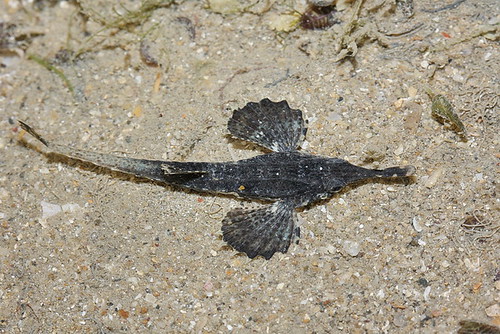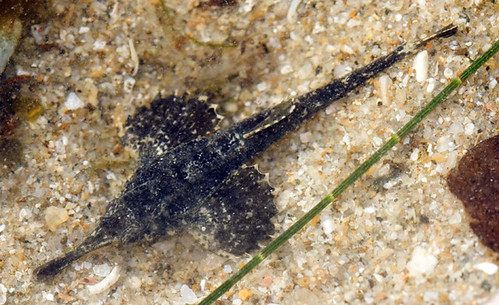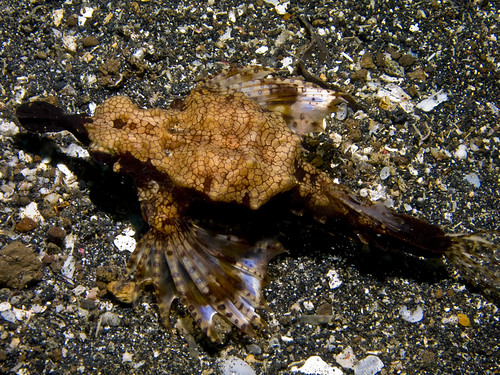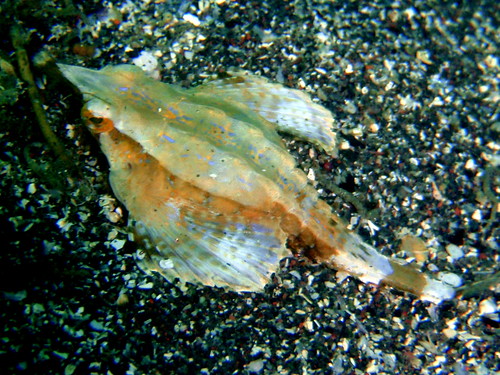
Kusu Island;
(Photo by James)
There really are quite a number of fishes with dragon-inspired names. Today, we'll look at a family of really bizarre-looking fishes which can be found in Singapore.
The seamoths (F. Pegasidae), also sometimes known as dragonfishes or sea robins, are a group of small armour-plated fishes found in calm shallow waters of the Indo-Pacific, such as in shallow bays and estuaries. Flattened, and with large wing-like pectoral fins, they 'walk' across the surface of the seabed with modified pelvic fins. Seamoths possess a long, stiff snout, and protrusible jaws, which form a long tube to suck up worms and shrimps. Interestingly enough, seamoths regularly shed their skin in one piece, presumably to remove growths of algae and other organisms on their bodies. Seamoths are thought to be monogamous, and are often found in pairs. They are broadcast spawners, with pairs swimming upwards at dusk and releasing their eggs and sperms into the water.

Tanah Merah;
(Photo by Ria)
The species present in Singapore is the longtail seamoth (Pegasus volitans), also known as the slender seamoth. This is the largest of the seamoths, growing up to 18 centimetres in length, and is found in sandy coastal areas, often close to seagrass beds, in places such as Changi, Pulau Ubin, Pasir Ris, Tanah Merah, Cyrene Reef, and Kusu Island. Globally, it is distributed from the eastern coast of Africa to southern China, the Philippines, and Australia.

Kusu Island;
(Photo by Marcus)

Changi;

Tanah Merah;

Pasir Ris;
(Photos by Ria)
Seamoths are commonly thought to belong to the Gasterosteiformes, which would make them related to the sticklebacks (F. Gasterosteidae) and tubesnouts (Aulorhynchidae). However, they are now often considered to be members of the Syngnathiformes, which would make them relatives of the similarly armour-plated pipefishes and seahorses (F. Syngnathidae) and razorfishes (F. Centriscidae).

Kusu Island;
(Photo by Ria)
There are 5 species of seamoth, split into 2 genera.

Dragon seamoth (Eurypegasus draconis);
(Photo by Ben Naden)
The dragon seamoth has a widespread distribution, being found in shallow areas from the eastern coast of Africa to southern Japan and Australia, all the way to French Polynesia. The closely related Hawaiian seamoth (Eurypegasus papilio) is endemic to Hawaii, where it is the only species of seamoth present.

Brick seamoth (Pegasus laternarius);
(Photo by Nemo's great uncle)
The brick seamoth is found from southern India and Sri Lanka to the Gulf of Thailand and the South China Sea, extending up the coast of China and Taiwan to southern Japan.

Sculptured seamoth (Pegasus lancifer);
(Photo by Soul Diver)
The sculptured seamoth has a much more restricted range, being endemic to southern Australia and Tasmania.
Seamoths are occasionally available in the marine aquarium trade, although they are supposedly very difficult to care for in captivity, even more so than seahorses.
However, a greater threat comes from the demand for seamoths in traditional Chinese medicine, particularly in Hong Kong and the provinces of Guangxi, Guangdong, and Hainan in southern China. Seamoths are not mentioned in any traditional Chinese medicine references, and their exploitation for medicine is very recent. Sold dried like seahorses, these fishes are used to cure respiratory ailments, lymph node and thyroid disorders, and to remove phlegm and abnormal secretions. Rumours also credit seamoths with curing throat and breast cancer.


Dried seamoths for sale as traditional Chinese medicine;
(Photos from a trader on Alibaba China)
According to a 1997 paper that looked at the trade in seamoths:
Pegasids are commonly consumed as tonic foods, rather than prescription medicines. A pocket manual for the general public claims that pegasids function to reduce coughing and mucous production (associated with children's bronchial infections in particular), and to improve sexual function and kidney function (Li and Lin, 1992). They are also considered helpful in curing goitres and diarrhoea following measles. For most treatments, the patient buys a dried pegasid, boils it with other ingredients and then drinks the liquid. For example, the cure for goitre requires the patient to mix seven to eight dried pegasids with pork to make a soup. The liquid and the constituent ingredients are ingested once daily for 3-4 days (Li and Lin, 1992). Some Hong Kong residents boil seahorses with salt pork and sweet olives to cure sore throats (F. Wong, pers. comm.).
Most uses for pegasids (with the exception of cancer treatments) are the same as those for seahorses, and the former are reportedly increasingly employed where the latter would have been preferred (but are unavailable or too expensive). In addition, pegasids (海雀) are blended with seahorses (海马), pipefishes (海龙) and sea snakes (海蛇) in a folk medley called 'Sea Treasure' (海宝). This is claimed to act as a general tonic and aphrodisiac, increasing blood circulation, reducing wind, and cooling the body.

(Photo from a trader on Alibaba China)
The pattern of the rise in trade of seamoths for Chinese medicine follows that seen in seahorses. Initially, seahorses entered the traditional Chinese medicine market as bycatch from domestic trawlers. Eventually, as demand grew, seahorses were sourced from other countries in the region, such as Vietnam, the Philippines, and Indonesia. Today, with seahorses heavily overfished in many parts of their range in Southeast Asia, attention has turned towards seamoths.

(Photo from a trader on Alibaba China)
Given that seamoths, just like seahorses, are not very mobile, live in pairs, and do not have high population densities, they are also at great risk of being overexploited, though much of the problem lies with the indiscriminate nature of bottom trawling. A more recent study, published in 2004, notes that divers in the Philippines have already reported declines in the abundance of seamoths. In 1996 alone, approximately 130,000–620,000 longtail seamoths and 130,000 dragon seamoths were landed off north-western Bohol. Habitat degradation through pollution, development, dredging, and destruction of seagrass meadows definitely also affects seamoth populations.

(Photo from a trader on Alibaba China)
Next up, more armour-plated fishes named after dragons.